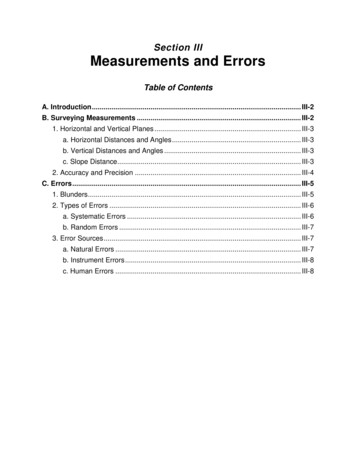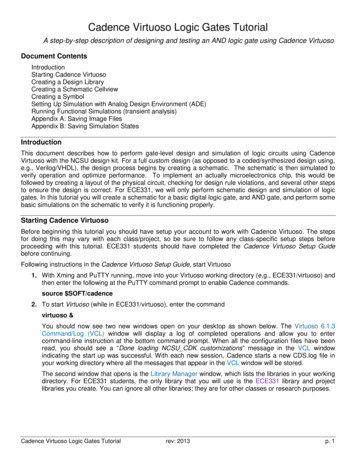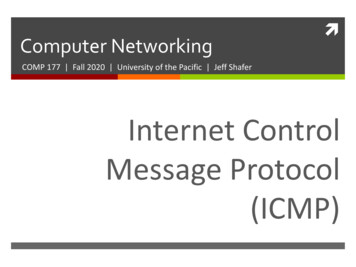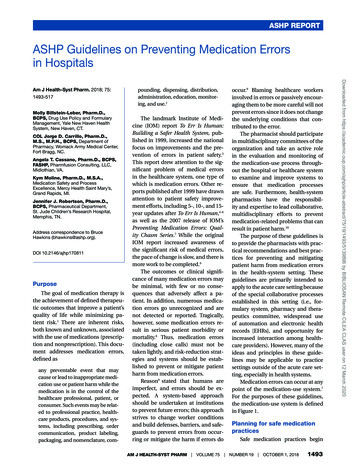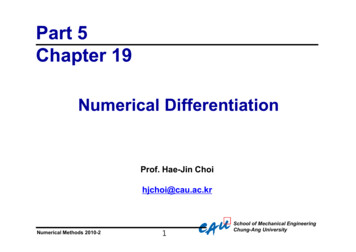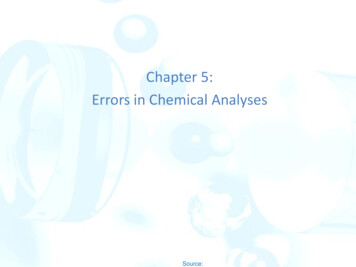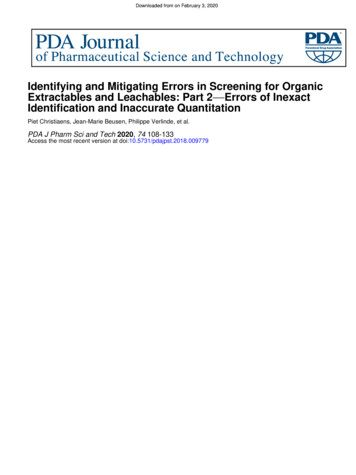
Transcription
Downloaded from on February 3, 2020Identifying and Mitigating Errors in Screening for OrganicExtractables and Leachables: Part 2 Errors of InexactIdentification and Inaccurate QuantitationPiet Christiaens, Jean-Marie Beusen, Philippe Verlinde, et al.PDA J Pharm Sci and Tech 2020, 74 108-133Access the most recent version at doi:10.5731/pdajpst.2018.009779
Downloaded from on February 3, 2020TECHNOLOGY/APPLICATIONIdentifying and Mitigating Errors in Screening for OrganicExtractables and Leachables: Part 2—Errors of InexactIdentification and Inaccurate QuantitationPIET CHRISTIAENS1, JEAN-MARIE BEUSEN1, PHILIPPE VERLINDE1, JAN BAETEN1, and DENNIS JENKE1,*Nelson Labs, Romeinsestraat 12, 3001 Heverlee, Belgium PDA, Inc. 20201ABSTRACT: Patients can be exposed to leachables derived from pharmaceutical manufacturing systems, packages, and/or medical devices during a clinical therapy. These leachables can adversely decrease the therapy’s effectiveness and/oradversely impact patient safety. Thus, extracts or drug products are chromatographically screened to discover, identify,and quantify organic extractables or leachables. Although screening methods have achieved a high degree of technicaland practical sophistication, they are not without issues in terms of accomplishing these three functions. In this Part 2of our three-part series, errors of inexact identification and inaccurate quantitation are addressed. An error of inexactidentification occurs when a screening method fails to produce an analyte response that can be used to secure the analyte’s identity. The error may be that the response contains insufficient information to interpret, in which case the analytecannot be identified or that the interpretation of the response produces an incorrect identity. In either case, proper use ofan internal extractables and leachables database can decrease the frequency of encountering unidentifiable analytes andincrease the confidence that identities that are secured are correct. Cases of identification errors are provided, illustrating the use of multidimensional analysis to increase confidence in procured identities. An error of inaccurate quantitation occurs when an analyte’s concentration is estimated by correlating the responses of the analyte and an internalstandard and arises because of response differences between analytes and internal standards. The use of a database containing relative response factors or relative response functions to secure more accurate analyte quantities is discussedand demonstrated.KEYWORDS: Extractables, Leachables, Chromatographic analysis, Screening analysis, Identification, Database, Quantitation, Internal standard, Response factor.IntroductionWhen drug products are manufactured, packaged, andadministered, they unavoidably and inevitably contactitems such as manufacturing components, packagingsystems, and administration devices. During contact,substances present in or on these items can be transferred to the drug product where they become foreignimpurities known as leachables. When a drug productis administered to a patient during clinical therapy,the patient is exposed to the leachables. As foreignimpurities, leachables could adversely affect the* Corresponding Author: Triad Scientific Solutions,LLC, 181 Peregrine Lane, Hawthorn Woods, IL 60047;Telephone: (1)-847-393-3151; : 10.5731/pdajpst.2018.009779108drug product’s suitability for its intended use,including patient and user health and drug productattributes such as quality, stability, efficacy, andcompliance.Thus, drug products are tested for foreign impurities(leachables), and extracts of contacted items are testedfor extractables (as potential or probable foreignimpurities) so that the foreign impurities can be identified, quantified, and ultimately assessed for potentialadverse effects (1, 2).When an extract is tested for organic extractables (or adrug product is tested for organic leachables), thedesired outcome is to account for all extractablesuniquely present in an extract (versus an extractionblank) above an established threshold or to establish allleachables uniquely present in a drug product above anestablished threshold. This desired outcome is achievedPDA Journal of Pharmaceutical Science and Technology
Downloaded from on February 3, 2020by analyzing the extract or drug product (and any associated blank or control) with chromatographic methodsthat are able to produce useful and interpretableresponses for potential extractables or leachables (3–5). If the extractables in an extract or leachables in adrug product are not or cannot be specified upfront,they must be discovered, identified, and quantified byan analytical process termed screening.In Part 1 of this series (6), the process of chromatographically screening extracts or drug products for organic extractables or leachables was established ashaving three primary objectives:1. accounting for (discovering) organic substances(extractables or leachables) present in a test sampleat a concentration above a defined threshold;2. identifying the discovered substances; and3. quantifying the identified substances.As was also noted previously, practical and scientific limitations of the chromatographic screening process impedethe process’s ability to fully accomplish these objectives.Thus, Part 1 of the series also considered errors of omission, where an error of omission involves the situationthat the screening method fails to produce a recognizableresponse for one or more of the analytes present in a sample (extract or drug product). Thus, the omission errorinvolves the discovery aspect of screening.Once all of the extractables in an extract or leachablesin a drug product at levels above a justified reportingthreshold have been accounted for (discovered), theidentities of the individual extractables or leachablesmust be established as identity links an extractable orleachable to that information which enables its assessment. Considering safety, for example, it is the extractable’s identity that links the extractable to its relevanttoxicological safety information. Clearly, if an identitycannot be secured or if the secured identity is incorrect(errors of inexact identification), then either the assessment cannot be performed or the assessment that isperformed is faulty. Additionally, the discovered extractables must be quantified, as it is the quantity of an extractable in an extract (or a leachable) in a drug productthat establishes a patient’s exposure (or potential exposure) to the substances. Clearly, inaccurate quantitationslead to erroneous safety assessments that either underestimate or overestimate the safety hazard.Vol. 74, No. 1, January--February 2020Errors of Inexact IdentificationIdentification HierarchyAs was noted in Part 1 of this series, although a screening assay produces a response that contains informationthat can be used to infer an identity, the response itselfis not an identity. It is only with further processing and/or interpretation that the response’s information canlead to an identification. Thus, screening methods do notidentify substances; rather, the screening method produces data that are further interpreted to provide anidentity.Rigorously speaking, an error of inexact identificationoccurs when (1) the response contains no identifyinginformation, (2) an identity cannot be inferred from theresponse data, or (3) the inferred identity is not the correct identity. Understanding and addressing errors ofinexact identification is facilitated if one understandsthe data interpretation process that is most commonlyused for compound identification. The process is basedon the observation that an identification derived frominformation represents a guess at the identity, where theconfidence one has in the guess depends on the amountand the nature of the information that suggests, supports, and ultimately confirms the identification. Themore information that is available, and the more rigorous the available information, the greater confidenceone can have that the inferred identity is the correctidentity. Thus, one can “grade” an identification basedon the level of confidence one has that the identificationis correct. Such a “grading” is captured, for example, inUSP 1663 Assessment of Extractables Associatedwith Pharmaceutical Packaging/Delivery Systems (5).In this monograph, four “grades” of identifications areproposed: unidentified, tentative, confident, and confirmed. These various “grades” are ranked in terms ofconciseness; thus, for example, a tentative identificationspecifies the chemical class of a substance, a confidentidentification specifies a specific structure that precludes all but the most closely related structures, and aconfirmed identification specifies an exact identification. Moreover, USP 1663 describes what type ofsupporting analytical information is required to movefrom one identification “grade” to a higher “grade”.An alternate, albeit similar, approach to identification“grading” is illustrated in Figure 1, which introduces afifth identification “grade”, partial. Furthermore, thetentative and confirmed grades are divided into two109
Downloaded from on February 3, 2020Figure 1Identification hierarchy.subgrades depending on the means by which the tentative or confirmed identification is secured. Understanding this “grading” scale is facilitated if one considers theidentification process most commonly employed withthe chromatographic methods used in extractions andleachables (E&L) screening.In understanding the identification process, one notesthat the information most commonly collected andused for E&L identification purposes is a mass spectrum. The chromatographic methods used for screeningemploy mass spectral detectors and thus the resultantresponse to an eluted analyte is its mass spectrum. Incertain circumstances, the mass spectrum may provideenough information to infer the structural characteristics of the compound of interest (i.e., the spectrum maycontain certain diagnostic masses) but will not provideenough definitive information to link the mass spectrum to a specific compound (secure a tentative identity). This level of identification is thus termed a partialidentification. For example, reporting that a compoundis a phthalate, but not being able to specify the specificphthalate means that the identity is partial. Althoughclearly a rigorous toxicological safety assessment cannot be based on a partial identity, partial identities maybe sufficient to facilitate some level of safety assessment.For example, quantitative structure–activity relationship110(QSAR) analysis of a compound’s structural characteristics (e.g., via DEREK or SARAH), can be used to establish whether the structural characteristics are associatedwith an increased risk of an adverse safety effect (e.g.,mutagenicity). Compounds without QSAR-alerting structures represent less of a safety hazard than do compoundswith QSAR-alerting structures.If we have the situation that the mass spectrum is sufficiently robust that a name can be proposed for the compound, such a tentative identification can be secured inone of two ways: (1) the mass spectrum can be linkedto a mass spectral library to find a matching spectrum(which implies that the compound that produced thelibrary spectrum is the compound that produced the analytical spectrum) or (2) the mass spectrum can beinterpreted from first principles to infer the analyte’sstructure (and thus its identity), a process that is termedstructure elucidation. Thus, a compound can be identified, in a tentative way, based on one-dimensional dataanalysis such as matching or elucidation (interpretation).If an external mass spectral database or library (i.e., adatabase constructed and populated by a third party)exists, then mass spectral matching can be performed.For example, the NIST/Wiley MS libraries are oftenutilized to secure identities in gas chromatography–PDA Journal of Pharmaceutical Science and Technology
Downloaded from on February 3, 2020mass spectroscopy (GC-MS) analyses. In this case, themass spectrum obtained for a compound via a screeningmethod is compared to the mass spectra contained in thedatabase, establishing those compounds in the databasewhose mass spectra closely match the spectrum of interest. Closely matching spectra are assigned a “matchscore” by a number of algorithms, with a higher matchscore corresponding, at least in principle, to the moreprobable identification. If a suitable match is obtained,then the identification is classified as tentative as one piece of supporting information has been secured (onedimensional identification).If a match is not secured or in the complete absence ofany database, the analyte is initially classified as unidentified (or unknown, as this term is commonly used)and remains unidentified until further actions are takento establish its identity. For example, identification ofan unidentified extractable can be accomplished via theprocess of structure elucidation, which involves theprofessional interpretation of the available mass spectral information. For instance, an expert could interpretthe mass spectrum’s fragmentation pattern to elucidatethe analyte’s probable functional groups and structuralunits. The individual groups and units can then be“assembled” to infer all or part of the analyte’s structure. Generally, the elucidation process is inefficientand is prone to error and variation, as individualexperts could easily come to different outcomes basedon their experience and capabilities. Such an identification so secured is interpretive by its very nature and isproperly classified as a tentative identification as it isbased on one-dimensional data (hence the additionalidentification “grade” in Figure 1).impact assessment can only be obtained when the tentative identity is “elevated” in grade by securing confirmatory information (two-dimensional identification). Thatis, one’s confidence that an identity is correct is increased(a tentative identification becomes a confident identification) when a second dimension of confirmatory data issecured. For example, although a mass spectral matchand an NMR interpretation separately produce tentativeidentities, the combination of a mass spectral match andan NMR interpretation would produce a confident identity as these are reinforcing pieces of information.The term “confirmed” identity is typically reservedfor an analyte whose tentative or confident identityhas been investigated by analysis of a reference standard of the inferred compound (three-dimensionalidentification). The lower “grade” identification is confirmed if the key properties of the analyte have beenmatched to the key properties of the reference standard(e.g., mass spectral match and retention time match).However, one can envision a situation where the identification is supported by such a preponderance or“critical mass” of data (e.g., a three-dimensional identification) that it is virtually impossible that the identification can be in error. In such a case, surely theidentity has been confirmed by the supporting data;thus, the possibility that a confirmed identity can besecured by either the traditional process of authenticstandard matching (standard-based) or by the preponderance of mutually supporting data (data-based) isshown in Figure 1.A third method for securing the identity of an unidentified analyte is to collect additional information about theanalyte by subjecting the test sample to another methodof analysis. For example, when it is possible to obtainand interpret a nuclear magnetic resonance (NMR) spectrum for the analyte, the interpretation could lead to theanalyte’s tentative (or perhaps confident) identification.Given the “grading” scale, clearly an unidentifiedanalyte reflects one type of error of inexact identification (i.e., the inability to secure an identity). Analytesthat have been either partially or tentatively identifiedcan be subject to the other error of inexact identification, which is misidentification. Given the additionalconfirmatory information that is required to secure aconfident or confirmed identification, these identifications are not generally prone to inexact identificationerrors.At this point in the identification process, we have eitheran unidentified analyte or an analyte that has been tentatively identified. Clearly, an unidentified analyte cannotbe assessed for its impact (e.g., its effect on patientsafety). Although an analyte that has been tentativelyidentified can be assessed for impact, it is understood thatsuch an assessment is provisional as the certainty in theanalyte’s identity is lower. It is understood that a properLastly, it surely is the case that the distinction betweena confident and a confirmed identity is vague andunclear, and that cases of high confidence (supported,for example, by three dimensions of compelling information) might, for all practical purposes, be consideredto produce a confirmed identity. It such cases it is thehigh degree of confidence that is more important andthe exact “grade” that is less important.Vol. 74, No. 1, January--February 2020111
Downloaded from on February 3, 2020Error of Inexact Identification: A Fatal ErrorCommission of an error of inexact identification is afatal error because such an error precludes a properassessment. If the error of inexact identification is thatan identity cannot be secured, then clearly the substance’s impact on the drug product’s suitability cannot beassessed as the link between the extractable and its relevant related information cannot be established. If theerror of inexact identification is that the wrong identityis secured (see Figures 2–7 for examples of this type ofidentification error), then clearly the substance’s impacton the drug product’s suitability cannot be correctlyassessed. This is the case as the assessment is based oninformation relevant to what could be a completelyunrelated compound.The existence of an external database, that is, a database constructed and populated by a third party,addresses the aspect of errors of inexact identificationto a certain extent. For example, as noted previously,the NIST/Wiley MS libraries are often utilized tosecure identities in GC-MS analyses. In this case, themass spectrum obtained for a compound via a screening method is compared to the mass spectra containedin the database, establishing those compounds in thedatabase whose mass spectra closely match the spectrum of interest. Closely matching spectra are assigneda “match score” by a number of algorithms, with ahigher match score corresponding, at least in principle,to the more probable identification.“Simple” Identifications Using an External DatabaseAlthough spectral matching via an external database isa commonly employed and generally effective meansof securing a compound’s tentative identity, it is notwithout its problems. The first and foremost problem isthat the more commonly used databases were not constructed with the intent of systematically, specifically,and completely addressing extractables or leachables.Rather, the external databases were constructed andpopulated to include compounds relevant to differentsituations encountered in a broad range of differentindustries (food, chemical, environmental, pharmaceutical, and so forth); thus, the presence of extractables/leachables in these databases is incidental as opposedto intentional.For example, many organizations involved in E&Ltesting refer to the Environmental Protection Agency112(EPA) Methods for Environmental Monitoring of Toxicor Hazardous Compounds (e.g., Method 8260 for Volatile Organic Compounds; Method 8270 for Semi-Volatile Organic Compounds) (7, 8) as a proper and validmethodology to discover, identify, and quantify extractables. Indeed, these methods will detect, identify, andquantify the many toxic and hazardous compounds thatare targeted by each EPA method in an accurate andprecise way. The selection of target compounds forthese EPA methods was based on a careful evaluationof compounds that could be released into the environment in large enough quantities by a broad range of different industries that they could have a detrimentaleffect on the environment.This aspect of the external database may confound itsuse in extractables or leachables screening. A carefulevaluation of these lists of compounds suggests thatonly 10% of the volatile substances on the EPA list arerelevant as volatile organic extractables and only 5%of the semivolatile compounds on the EPA list are relevant as semivolatile extractables or leachables. Thus,the EPA database linked to its methods does notinclude many of the commonly encountered extractables and includes a majority of compounds that arenot extractables.This situation produces two issues. The first issue is thecontent of the external database. Because the EPAdatabase does not contain a large number of potentialextractables, an extractable that needs to be identifiedis likely not in the database and thus a match will notbe secured. If a match cannot be secured then clearlyan identity cannot be proposed. Thus, the first issue isobtaining no identification, essentially concluding thatthe substance in question is unidentifiable.The second issue is securing the wrong identity becauseof both the size and the content of the external database. Because the external databases contain so manycompounds that are not extractables (e.g., the combinedNIST/Wiley ’17 Mass Spectral Library contains over 1million mass spectra (9)), possibly a target spectrumwill be closely matched to spectra from compoundsthat are not extractables, leading to false identifications.This problem is exacerbated to a certain extent bysecuring “simple identities”, which, for example, is theprocess of accepting that a compound’s identity isestablished by the match with either the highest matchscore or an acceptably high match score. Although thematch score is an effective means of differentiatingPDA Journal of Pharmaceutical Science and Technology
Downloaded from on February 3, 2020Figure 2Example of an exact identification via mass spectral fit with an authentic standard (1,1’-carbonothioyl-bispiperidine) in the Database (with retention time confirmation) versus an inexact “simple” identification, relying onlyon the mass spectral fit with the external NIST/Wiley mass, leading to a fatal identification error (incorrectlyidentified as 1-aminocyclopentane-carboxylic acid, N-hexyloxy-carbonyl, isohexyl ester).potential identities from unlikely or impossible identities, the resolution between similar match scores is notalways adequate to arbitrarily select the proper matchbased on generalizations such as “the highest match scorealways wins” and “any identity with a match score above80 must be a good identity”.Vol. 74, No. 1, January--February 2020Home Court Advantage of an Internally DevelopedDatabaseThese issues notwithstanding, perhaps the most significant issue associated with use of an external databaseis the degree to which the experimental conditions113
Downloaded from on February 3, 2020Figure 3Example of an exact identification via mass spectral fit with an authentic standard (dicyclopentylsilanediol) inthe Database (with retention time confirmation) versus an inexact “simple” identification, relying only on themass spectral fit with the external NIST/Wiley mass, leading to a fatal identification error (incorrectly identified as 4-pentenoic acid, 2,2-diethyl-3-oxo-5-phenyl-, ethyl ester).used to produce the information in the external database match the analytical conditions employed by theindividual testing laboratory. The closer the matchbetween the analytical conditions used to generate theinformation in the database and the analytical conditions that produced the information to be matched to114the database, the better will be the outcome of thematch (which is a potential identification). The poorerthe match between analytical conditions, the morelikely that either no identifications or false identifications will be generated when matching experimentaldata to the database.PDA Journal of Pharmaceutical Science and Technology
Downloaded from on February 3, 2020Figure 4Example of an exact identification via mass spectral fit with an authentic standard (1,4,7-trioxacyclotridecane8,13-dione) in the Database (with retention time confirmation) versus an inexact “simple” identification, relyingonly on the mass spectral fit with the external NIST/Wiley mass, leading to a fatal identification error (incorrectly identified as succinic acid, 2-(2-chloro-phenoxy)ethyl ethyl ester).For example, consider the case of mass spectral matching in GC. Because the industry has standardized theionization conditions (electron impact at 70 eV), for anumber of extractable and leachable compounds thereis a generally good correlation between spectra in anexternal database and spectra obtained by independentlaboratory analyses. However, lack of standardizationVol. 74, No. 1, January--February 2020in MS applied in liquid chromatography (LC) meansthat likely spectra contained in an external databasewere not collected under conditions that match the conditions used by an independent laboratory to collect itsspectra, thus increasing the possibility that matchingbetween the external database and the independent laboratory will produce aberrant identities.115
Downloaded from on February 3, 2020Figure 5Example of an exact identification via mass spectral fit with an authentic standard (PBT dimer) in the Database(with retention time confirmation) versus an inexact “simple” identification, relying only on the mass spectralfit with the external NIST/Wiley mass, leading to a fatal identification error (incorrectly identified as ine).Most of the problems associated with the use of anexternal database are solved or ameliorated via application of an internally generated database. As the internal database contains only extractables and as theinternal database is grown to include a significantnumber of extractables, the issues noted earlier in116terms of producing no hits or producing aberrant hitsare reduced.Furthermore, the concept of “home court advantage” comesinto play. That is, when a laboratory produces an internaldatabase it certainly does so with the exact analyticalPDA Journal of Pharmaceutical Science and Technology
Downloaded from on February 3, 2020Figure 6Example of an exact identification via mass spectral fit with an authentic standard (chlorinated rubberoligomer C13H23Cl) in the Database (with retention time confirmation) versus an inexact “simple” identification, relying only on the mass spectral fit with the external NIST/Wiley mass, leading to a fatal identificationerror (incorrectly identified as bicyclo[3.2.0]heptan-2-one, 6-hydroxy-5-methyl-6-vinyl-).methods and conditions it uses to screen extracts forextractables (and drug products for leachables). Becausethe laboratory conditions for producing the reference andtest spectra are closely matched, the test and database spectra will be more closely matched, resulting in better matchscores that will more effectively differentiate the true identity from a smaller number of false potential identities.Vol. 74, No. 1, January--February 2020Home Court Advantage in Action: Examples of InexactIdentification Resulting from Spectral Matching via anExternal Database (Commercial Spectral Library)Figures 2–7 provide examples that illustrate errors ofidentification propagated via spectral matching to anexternal database and corrected via matching to an117
Downloaded from on February 3, 2020Figure 7Example of an exact identification via mass spectral fit with an authentic standard (brominated rubberoligomer C13H23Br) in the Database (with retention time confirmation) versus an inexact “simple” identification, relying only on the mass spectral fit with the external NIST/Wiley mass, leading to a fatal identificationerror (wrongly identified as ethanone, 1-(3,3-dimethylbicyclo[2.2.1]hept-2-yl)-, exo-).internal database. In each example, an electron impact(EI) mass spectrum was obtained for the compound andthe compound’s possible identity was secured by spectral matching to either an external commercial spectraldatabase (NIST/Wiley) or an internal spectral database(generated by Nelson Labs, hereafter referred to as the118“Database”) constructed from the analytical informationobtained through analyzing authentic standards via thegeneric screening method for GC-MS.Each example includes the analytically obtained data(retention time and mass spectrum) as well as data forPDA Journal of Pharmaceutical Science and Technology
Downloaded from on February 3, 2020the “best hit” from each of these libraries, includinglibrary retention time in minutes (if available), spectralmatch score (%), spectrum, and structure. In all cases,the identity obtained with the internal database is correct whereas the identity obtained with the externaldatabase is incorrect.The example in Figure 7 provides an opportunity toexplore the difference between a partial and a tentativeunknown. Let us, for a moment, imagine that the Database entry for this compound does not exist, meaningthat either the investigator seeking to identify the compound does not have the database or that the databasedoes not contain this compound. The investigator wouldhave the match to the NIST/Wiley database to workwith but the low match score and a visual comparison ofthe test spectrum to the match spectrum both suggestthat the match is not the right identity for the test compound. Thus, without a match, an identification of “unidentified” seems proper. However, clearly the massspectrum is interpretable, with the most obvious featurebeing the clear indication that the compound containsbromine (
for extractables (as potential or probable foreign impurities) so that the foreign impurities can be identi-fied, quantified, and ultimately assessed for potential adverse effects (1, 2). When an extract is tested for organic extractables (or a drug product is tested for organic leachables), the desired outcome is to account for all extractables




